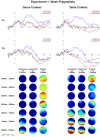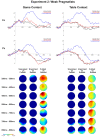The Cost of the Epistemic Step: Investigating Scalar Implicatures in Full and Partial Information Contexts
- PMID: 34349701
- PMCID: PMC8328393
- DOI: 10.3389/fpsyg.2021.679491
The Cost of the Epistemic Step: Investigating Scalar Implicatures in Full and Partial Information Contexts
Abstract
We present the first ERP experiments that test the online processing of the scalar implicature some ⇝ not all in contexts where the speaker competence assumption is violated. Participants observe game scenarios with four open cards on the table and two closed cards outside of the table, while listening to statements made by a virtual player. In the full access context, the player makes a fully informed statement by referring only to the open cards, as cards on the table; in the partial access context, she makes a partially informed statement by referring to the whole set of cards, as cards in the game. If all of the open cards contain a given object X (Fullset condition), then some cards on the table contain Xs is inconsistent with the not all reading, whereas it is unknown whether some cards in the game contain X is consistent with this reading. If only a subset of the open cards contains X (Subset condition), then both utterances are known to be consistent with the not all implicature. Differential effects are observed depending on the quantifier reading adopted by the participant: For those participants who adopt the not all reading in the full access context, but not in the partial access context (weak pragmatic reading), a late posterior negativity effect is observed in the partial access context for the Fullset relative to the Subset condition. This effect is argued to reflect inference-driven context retrieval and monitoring processes related to epistemic reasoning involved in evaluating the competence assumption. By contrast, for participants who adopt the logical interpretation of some (some and possibly all), an N400 effect is observed in the partial access context, when comparing the Subset against the Fullset condition, which is argued to result from the competition between the two quantifying expressions some cards on the table and some cards in the game functioning in the experiment as scalar alternatives.
Keywords: N400; alternatives; competence assumption; epistemic step; late posterior negativity; primary and secondary implicature; scalar implicature.
Copyright © 2021 Spychalska, Reimer, Schumacher and Werning.
Conflict of interest statement
The authors declare that the research was conducted in the absence of any commercial or financial relationships that could be construed as a potential conflict of interest.
Figures







References
-
- Bergen L., Levy R., Goodman N. (2016). Pragmatic reasoning through semantic inference. Semant. Pragmat. 9. 10.3765/sp.9.20 - DOI
LinkOut - more resources
Full Text Sources

